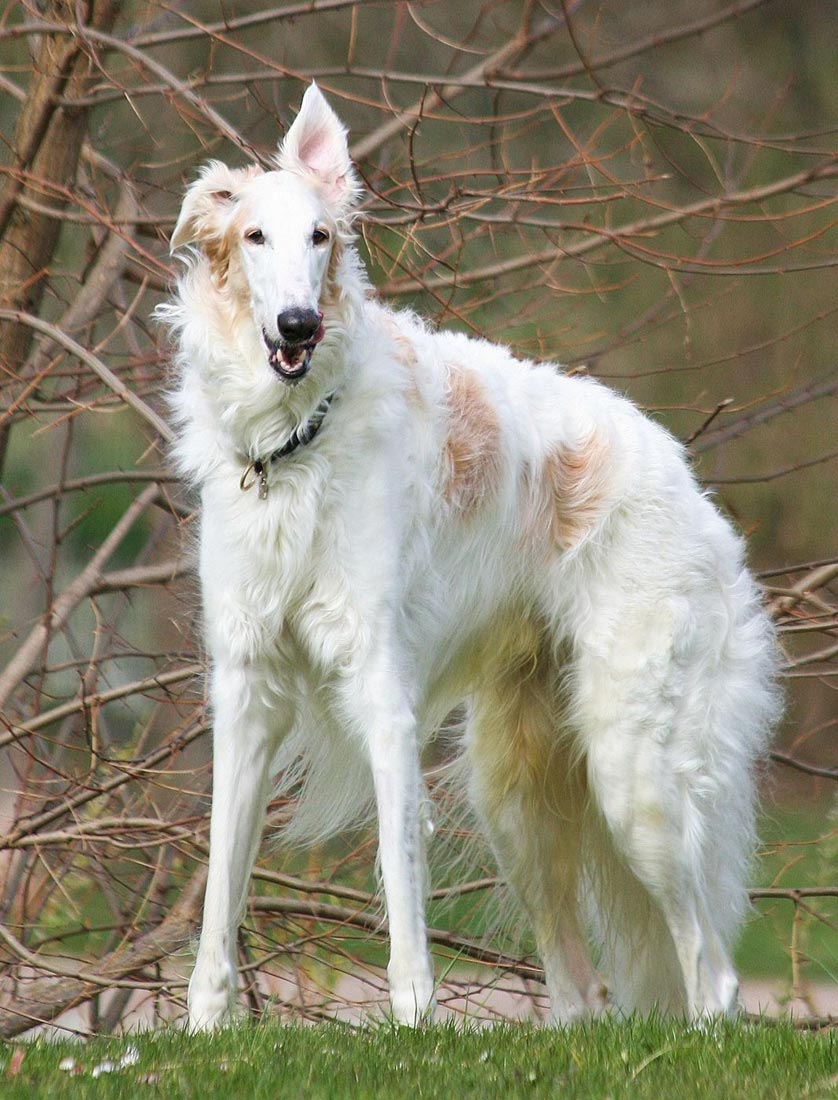
The Breed History
Perhaps as early as the 1200s, Russian aristocrats bred fast sight
hounds for hunting and the breed started to take form. Dogs such
as the Bearhound, southern coursing hounds of the Tartars, and
Owtchar sheepdogs were reported as progenitor breeds. Some also
report Saluki and Greyhound as part of the mix. The first breed
standard dates back to 1650. Aristocrats used to carry out elaborate
wolf hunts, using pairs or trios of Borzois, one horsemen and
foxhounds to flush quarry. The first specimen may have been sent
to England in 1842. The importation to America began in earnest in
the 1890s. The name in Russian is "borzii," meaning swift.
Breeding for Function
Historically, they functioned in the hunt to pin down the quarry
(usually wolves) until the horsemen arrived. They were also
successfully used to hunt fox and hare. Today they are popular in
lure coursing events, obedience, and as valued companions due to
their gentle nature and trainability.
Physical Characteristics
Height at Withers: female 26" minimum (66 cm), male 28"
minimum (71 cm).
Weight: females 75-90 lb (34-41 kg), males 75-105 lb (34-48 kg).
Coat: The coat is variably curly but long and silky. Short hair is
present over the head, and long feathers are found on tail and
hindquarters. They possess a prominent neck frill. Any color or color
combination is acceptable. Daily brushing and regular bathing are
recommended. They have a moderate shedding tendency.
Longevity: 9-13 years
Points of Conformation: Graceful movement and lithe
conformation characterize the Borzoi. Males are noticeably heavier
set than the females. The skull is very long and narrow, slightly
domed and somewhat Roman-nosed in profile. The stop is not
prominent, ears are small and obliquely set, eyes are dark with dark
palpebral rims. The nose is large and pigmented black. The thorax
is very deep and narrow, and neck slightly arched and muscular.
The topline is slightly curved, back is short, and abdomen is tucked
up. Long bones of the limbs appear oval; narrow when viewed
from the front, but are straight. The feet are well knuckled up and
the dewclaws are generally removed. Hindquarters are wider than
forequarters. Their long tail is set low and carried low in a curve. A
powerful springy gait is desired.
Recognized Behavior Issues and Traits
Reported breed characteristics include: Courageous in the hunt,
protective of their owners, tractable, intelligent, affectionate with
owners, sensitive, some are aloof, faithful, good with children (best
if raised with children); may chase cats or small dogs if not brought
up with them. Is active outdoors but quiet in the house, has
moderate to high exercise needs, and early training is needed. They
can sometimes be independent and a bit stubborn. If off leash, the
Borzoi should be in a fenced enclosure. Can be destructive if bored.
Considered alarm barkers not guard dogs.
Normal Physiologic Variations
Sight hounds have lower normal ranges for T4 and T3
concentrations compared to other breeds.
Drug Sensitivities
Anesthesia: Sight hounds require particular attention during
anesthesia. Their lean body conformation with high surface-areato-
volume ratio predisposes them to hypothermia during
anesthesia. Impaired biotransformation of drugs by the liver
results in prolonged recovery from barbiturate and thiobarbiturate
intravenous anesthetics. Propofol, and ketamine/diazepam
combination are recommended induction agents.
Inherited Diseases
Hypothyroidism: Breeding studies of autoimmune thyroiditis in
the breed suggest an autosomal recessive inheritance. Thyroid
auto-antibodies are usually present by 2.5 years of age. 11.5%
positive for thyroid autoantibodies based on testing at Michigan
State University. (Ave. for all breeds is 7.5%)
Elbow Dysplasia: Polygenically inherited trait causing elbow
arthritis. OFA reports 2.9% affected.
Hip Dysplasia: Polygenically inherited trait causing degenerative
joint disease and hip arthritis. The breed has uniformly tight hips,
and is used as the gold standard by PennHIP for judging joint
laxity (all have a DI < 0.32). OFA reports 1.8% affected with hip
dysplasia.
Patella Luxation: Polygenically inherited laxity of patellar
ligaments, causing luxation, lameness, and later degenerative joint
disease. Treat surgically if causing clinical signs. Too few Borzois
have been screened by OFA to determine an accurate frequency.
Cervical Malformation/Malarticulation (Wobblers Disease):
A congenital anatomical disorder that causes compression of
the cervical spinal cord. Clinical signs include limb weakness,
proprioceptive deficits, and paralysis. Evidence of an autosomal
recessive trait was found in this breed.
Disease Predispositions
Multifocal Chorioretinopathy: Borzoi's can develop a retinopathy
that does not progress once developed, and does not cause visual
abnormalities. Various studies have found 5.6% to 12% of adult
dogs with this lesion. Pedigree analysis and breeding studies rule
out a sex-linked or autosomal dominant mode of inheritance,
although male dogs predominate. CERF does not recommend
breeding any Borzoi with chorioretinopathy.
Mammary Cancer: Dorn reports a 17.06x odds ratio of developing
mammary cancer versus other breeds.
Gastric Dilation/Volvulus (Bloat): Life-threatening twisting of
the stomach within the abdomen. Requires immediate veterinary
attention. Dorn reports a 13.47x odds ratio of developing GDV
versus other breeds.
Cataracts: Anterior cortex punctate, and capsular cataracts
predominate in the breed. Unknown mode of inheritance. Identified
in 3.40% of Borzois CERF examined by veterinary ophthalmologists
between 2000-2005. CERF does not recommend breeding any
Borzoi with a cataract.
Persistent Pupillary Membranes: Strands of fetal remnant
connecting; iris to iris, cornea, lens, or involving sheets of tissue.
The later three forms can impair vision, and dogs affected with
these forms should not be bred. Identified in 1.44% of Borzois CERF
examined by veterinary ophthalmologists between 2000-2005.
Progressive Retinal Atrophy (PRA): Inherited degeneration of the
retina. Autosomal recessive inheritance in most breeds. 1.03% of
Borzois CERF examined by veterinary ophthalmologists between
2000-2005 are labeled suspicious for PRA.
Congenital Malformation of the Canine Tricuspid Valve:
Affected Borzois have a mild right-sided heart murmer with this
congenital condition. It is inherited as an autosomal dominant trait
with reduced penetrance in the Labrador Retriever. OFA reports
0.8% of Borzois have heart disease through cardiac evaluation.
Dilated Cardiomyopathy: Primary disease of heart muscle causing
arrythmias and heart failure. Unknown mode of inheritance.
Reported at an increase frequency in the breed. OFA reports 0.8% of
Borzois have heart disease through cardiac evaluation.
Degenerative Myelopathy (DM): Affected dogs show an insidious
onset of upper motor neuron (UMN) paraparesis. The disease
eventually progresses to severe tetraparesis. Affected dogs have
normal results on myelography, MRI, and CSF analysis. Necropsy
confirms the condition. Unknown mode of inheritance. A direct
genetic test for an autosomal recessive DM susceptibility gene is
available. All affected dogs are homozygous for the gene, however
only a small percentage of homozygous dogs develop DM. OFA
reports DM susceptibility gene frequencies of 25% carrier, and 2%
homozygous "at-risk".
Microphthalmia, Optic Nerve Hypoplasia, Stifle OCD,
Dysfibrinogenemia, Hypertrophic Osteodystrophy, Lymphedema,
Methemoglobin Reductase Deficiency, and Oligodontia are
reported.
Isolated Case Studies
Multisystemic Inflammatory Disease: Report of a 6 week-old
dog developing anorexia, temporary intention tremor, seizures,
episodic pyrexia, tachypnea, conjunctivitis, otitis and neck pain.
Hematological abnormalities included an inflammatory leukogram
and regenerative anemia. Post mortem examination revealed a
multisystemic inflammatory disease involving thyroids, lymph
nodes, spleen, pancreas, bladder and lung, but no lesions to account
for the neurological signs.
Cutaneous Malignant Histiocytosis: Report of a 4 year-old dog.
This is a multi-system, rapidly progressive disease in which there is
simultaneous involvement of multiple organs such as spleen, lymph
nodes, lung, bone marrow, skin and subcutis. The disease is poorly
responsive to treatment. A canine cell line (CCT) was established
from this dog.
Genetic Tests
Tests of Genotype: Direct test of K coat color alleles is available
from VetGen.
Direct tests for a DM susceptability gene is available from the OFA.
Tests of Phenotype: CHIC Certification: Required tests are; CERF
eye examination, thyroid profile including autoantibodies, cardiac
certification, and direct gene test for DM. Optional recommended
tests are; hip and elbow radiographs. Recommend patella evaluation.
Miscellaneous
- Breed name synonyms: Russian wolfhound, Psowaya Barsaya.
- Registries: AKC, UKC, CKC, KCGB (Kennel Club of Great Britain),
ANKC (Australian National Kennel Club), NKC (National Kennel Club).
- AKC rank (year 2008): 94 (630 dogs registered)
- Internet resources: Borzoi Club of America:
www.borzoiclubofamerica.org
Borzoi Canada: www.borzoicanada.ca
The Borzoi Club UK: www.theborzoiclub.org.uk
Photo Gallery of Breed - Borzoi - Dog Breed
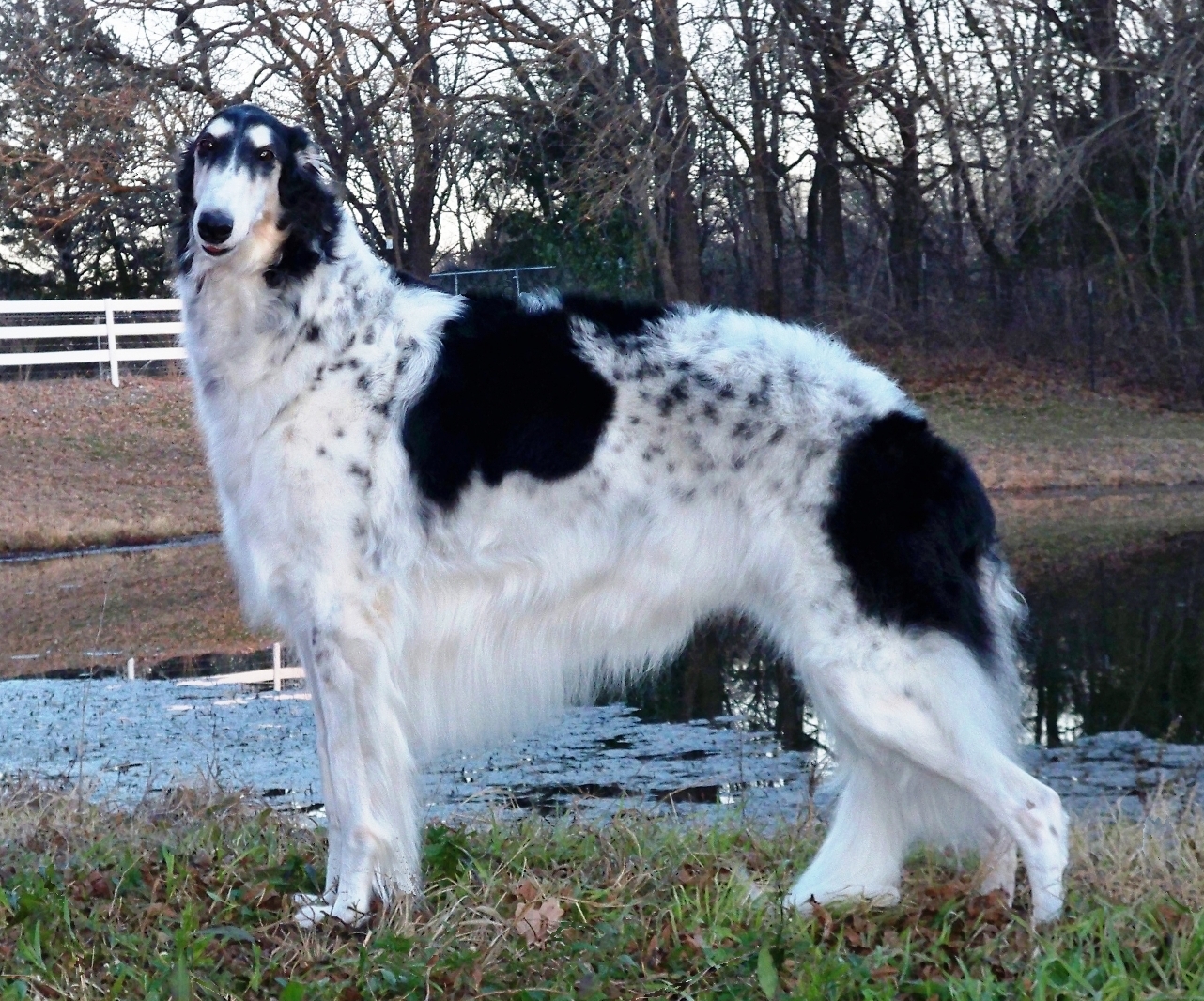

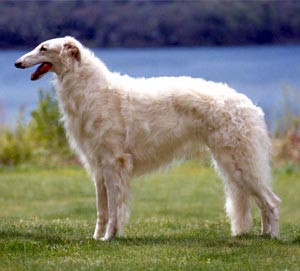
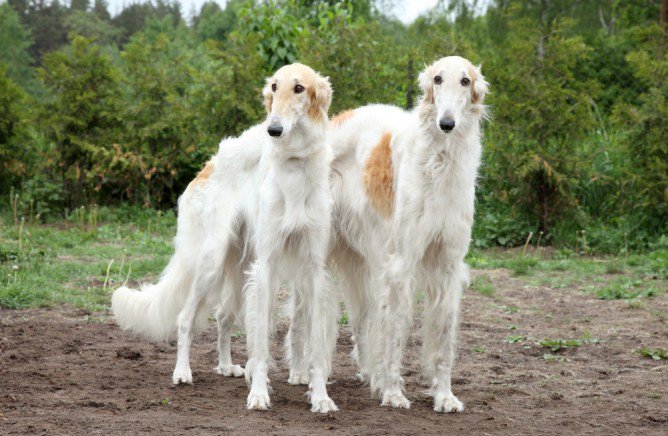


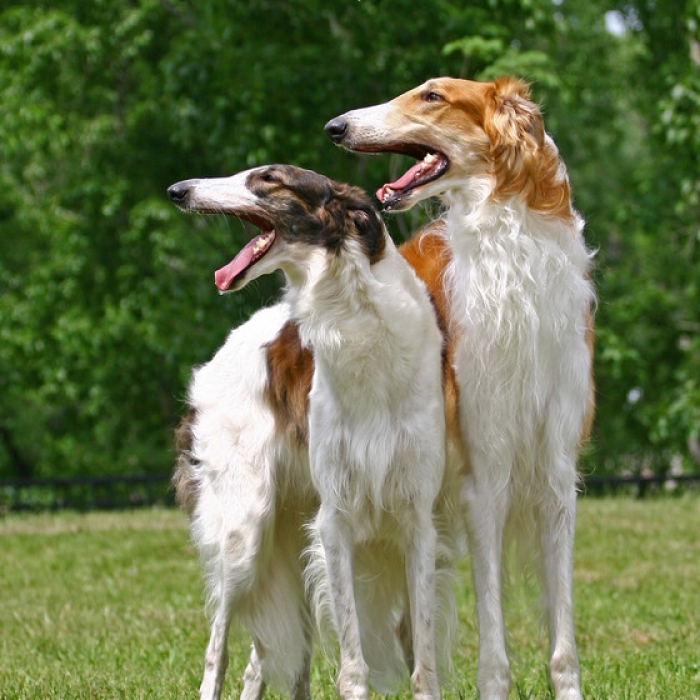
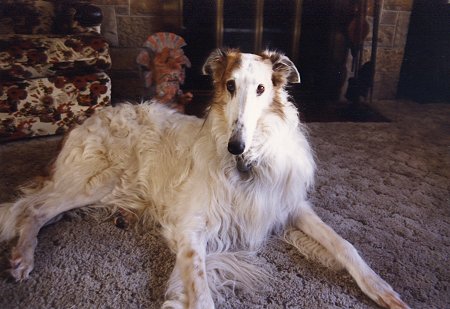
 Animalia Life
Animalia Life